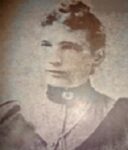
Annie M. Snyder
American, 1852-1927
Still Life: Basket of Grapes, 1890s
oil on academy board
14 x 20 in.
SBMA, Gift of JoAnn and Julian Ganz, Jr in memory of G. Ione McMahan
1976.8

Artist photo from Lock Haven State University Year Book
RESEARCH PAPER
This oil painting on academy board is entitled “Still Life: Basket of Grapes” and was painted by Annie Snyder in the 1890’s. Hers was a simple life which is reflected in the simplicity of her paintings. Her meager upbringing on a farm in Pennsylvania is symbolically represented in the simple but rich portrayal of the basket of grapes. This oil painting is extremely effective in attracting the attention of the viewer because of the artist's realism and incredible attention to detail. One can imagine tasting the delicious juiciness of the fruit.
The composition of the piece is well-balanced and there is a sense of wholeness between the oneness of the cluster of grapes and the basket. The composition is symmetrical with the handle dividing the painting in half. The horizontal line of the table intersects with the vertical line of the handle which draws our eyes to the focal point of the painting - the oneness of the grapes and the basket.
The squareness of the basket contrasts nicely with the roundness of the grapes and this round pattern is repeated in the nail dots on the rim of the basket. The stems of the grapes angle up toward the right of the table, and the basket rests upon a very plain surface, keeping with the theme of simplicity in the painting.
There are no rich fabrics to cover the table or a marbled counter top, like we see in so many still life paintings. The table is simply a base for the basket.
Notice how the blue-violet color of the grapes contrast with the tan of the basket. On the color wheel purple is a complementary color to yellow-tan. The background is dark to emphasize the grapes. Also the color of the grapes is echoed in the background and the tan color of the basket is reflected on the table.
There is so much visual texture in this painting. We feel as if we can reach out and touch the plumpness of the grapes and feel the roughness of the basket. Light draws our attention to the grapes on the front left side of the basket. And this light shining on the grapes on the left side of the basket versus the darker grapes on the right backside of the basket gives a feeling of depth.
Annie skillfully blended the colors in the grapes with white highlights, making them look very realistic. This painting appeals to our senses because of the very lushness of the desirable grapes. We are drawn by its beauty and by the serenity and calm that the arrangement exudes.
In the late eighteen hundreds it was the custom for people to decorate their homes with large numbers of easily understood paintings. Many homes had row upon row of paintings and that certainly would be the appeal of “Still Life: Basket of Grapes”.
But then, something happened in the 1890’s. Photography arrived in the United States and it began to compete with paintings. The realism of photography became the preference for many folks. So artists like Annie Snyder began to paint in a style that I would call hyper-realism. The subject matter is so realistic, it almost looks like a photograph. Hyper-realism easily competed with and triumphed over black and white photos. The paintings had colors and feelings that the black and white photos just couldn’t capture.
Annie Snyder was born in Salona, Pennsylvania in 1852. She had little art education other than some early instruction in Salona and in Philadelphia under Emil Kett, from Nuremberg, Germany. She struggled to make a living from art all her life and, at one point, was peddling raffle tickets for her paintings door to door. She lived for a time in Philadelphia but eventually returned to Salona and then Lock Haven, Pennsylvania by 1893, where she spent the rest of her life.
She opened a studio in her home and also sold paintings through Wanamaker's in Philadelphia, Macy's in New York, and various locations in the area where she lived in northern Pennsylvania. She also taught at Central State Normal School, now known as Lock Haven State University.
She stopped painting for the last five years of her life due to ill health. In 1927 Annie Snyder died from cancer just five days after her 75th birthday. She never married. Her life was not complicated. Rather simple. Her art was also very simple, unpretentious and so very realistic.
Prepared for the SBMA Docent Council by David Stoker, 2023
Bibliography
American Art Review editors. “American Women Artists: 1819-1947”. American Art Review, February 2003
American Art Review editors. “Things On The Table”. American Art Review, June 1994
Anonymous. “A Tribute To Annie Snyder”, The Loch Haven Express Newspaper, March 19, 2020
SBMA CURATORIAL LABELS
Annie Snyder remains critically neglected, even though, as this exquisite still-life attests, she possessed prodigious technical skill, especially with still-life subjects. Largely self-taught, Snyder came from an agricultural background and only sold the family farm and devoted herself entirely to painting in 1901 after the death of her mother. She earned her living by exhibiting her work in the windows of department stores and by the occasional commissioned portrait. The marketability of a simple still-life composition such as this is attested by its autograph close variation that recently sold at auction. Eventually, Snyder became sufficiently well-known to be commissioned to do large-scale decorations, such as The Seasons, still preserved in the Masonic temple of her hometown of Lock Haven, Pennsylvania.
- Preston Morton Reinstallation, 2022
